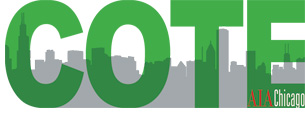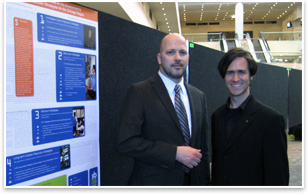Chicago COTE Unveils “Cool Tool” for Carbon Reduction
Tool offers 60 customizable strategies for immediate to long-term implementation
by Heather Livingston
Contributing Editor
 How do you . . . create a city- or region-specific action plan for implementing carbon reduction strategies? How do you . . . create a city- or region-specific action plan for implementing carbon reduction strategies?
Summary: AIA Chicago’s Committee on the Environment (COTE) released its “Carbon Reduction Strategies for the Chicago Region,” nicknamed the “Cool Tool,” at the World Sustainable Building Conference in Melbourne, Australia, last month.
The AIA Chicago Committee on the Environment (AIAChicago COTE) has developed a Carbon Reduction Strategies matrix that outlines 60 actionable steps that building owners can take to improve energy efficiency and reduce carbon emissions. Applicable for any building type, the steps are prioritized in four categories that range from immediate strategies as simple as turning off lights when not required to long-term approaches like mandating policy that promotes longer lasting buildings. Nicknamed the "Cool Tool" for its global warming reduction objective, the matrix was premiered at the World Sustainable Building Conference (SBO8) in Melbourne, Australia, on September 22.
 "The Cool Tool is a practical resource that everyone from homeowners to building industry professionals can use to reduce the impact of the built environment on global climate change," says Vuk Vujovic, AIA, LEED-AP, co-chair of AIAChicago COTE and director of sustainable design at Legat Architects. "By sharing our experiences with the Cool Tool at SB08, we hope that other cities throughout the world will use it as a springboard for their own energy and carbon emissions reduction plans." "The Cool Tool is a practical resource that everyone from homeowners to building industry professionals can use to reduce the impact of the built environment on global climate change," says Vuk Vujovic, AIA, LEED-AP, co-chair of AIAChicago COTE and director of sustainable design at Legat Architects. "By sharing our experiences with the Cool Tool at SB08, we hope that other cities throughout the world will use it as a springboard for their own energy and carbon emissions reduction plans."
Vujovic relates that the Cool Tool sprang from AIAChicago COTE’s longstanding relationship with the City of Chicago Department of Environment. The two organizations biannually renew a memorandum of understanding (MOU) that outlines priorities, initiatives, and outreach; the last in 2007. At that time, the organizations decided that they wanted to extend the impact of their MOU by making “the collective knowledge and abilities of a 3,000-strong chapter of architects available to the city.” The Cool Tool is the result of that collective knowledge.
Addresses 2030 shortcoming
Long recognized for his efforts to “green” Chicago, Mayor Richard M. Daley was one of four sponsors of the U.S. Conference of Mayors (USCM) Resolution 50, which supported that organization’s adoption of the 2030 Challenge put forth by Ed Mazria, FAIA. Although Vujovic supports the 2030 Challenge, he believes that “part of the issue with implementation of 2030 goals of carbon reduction is that those goals and the data … represent national averages. Places like Chicago are quite different from Florida or Washington State, so when we started crunching these numbers and trying to figure out how we can implement this, the first comment that we got from the engineering part was that we need something that is Chicago-based.” The resulting Cool Tool matrix can be applied to any building type in any city, but, Vujovic notes, city or region customization is critical to determining the numbers accurately because environmental conditions will differ by location.
Although the matrix currently is an Excel spreadsheet that may at first glance be reminiscent of a LEED™ checklist, Vujovic points out that whereas LEED gives the design team a yardstick against which to rate the building, the Cool Tool provides a path for reducing energy use and carbon emissions. “They don’t necessarily define the ways of how to do that,” he explains. “They also don’t correlate carbon emission and energy use with a particular strategy, so LEED is defining the targets but not necessarily defining the strategies of how to get there.”
 Fostering cooperation Fostering cooperation
AIAChicago COTE is hoping to expand the Cool Tool’s functionality by creating a wiki Web site, where architects can read about carbon reduction strategies, add to the Cool Tool, suggest strategies, or add resources, thereby creating a “living tool” that grows and evolves as new ideas emerge. They anticipate having the site available as soon as the first quarter of 2009. As for the City of Chicago, they currently are seeking a consultant to “help us crunch the numbers and identify the cost of implementation, energy savings, and carbon emissions associated with every strategy for the Chicago region,” says Vujovic.
Vujovic notes with pleasure that the Cool Tool was well received at SBO8. After the conference, AIAChicago COTE members spent some time with the Royal Australian Institute of Architects Victoria chapter’s Sustainable Architecture Forum (the chapter’s COTE counterpart) to share experiences and best practices. Vujovic believes that this international cross-pollination of sustainable strategies is critical because “if one city succeeds and these strategies actually work, then they can be extrapolated elsewhere and vice versa,” he explains. “In the end, everybody wins, and I think the idea of that unified work and cooperation is very important.”
| 

 How do you . . .
How do you . . .  "The Cool Tool is a practical resource that everyone from homeowners to building industry professionals can use to reduce the impact of the built environment on global climate change," says Vuk Vujovic, AIA, LEED-AP, co-chair of AIAChicago COTE and director of sustainable design at Legat Architects. "By sharing our experiences with the Cool Tool at SB08, we hope that other cities throughout the world will use it as a springboard for their own energy and carbon emissions reduction plans."
"The Cool Tool is a practical resource that everyone from homeowners to building industry professionals can use to reduce the impact of the built environment on global climate change," says Vuk Vujovic, AIA, LEED-AP, co-chair of AIAChicago COTE and director of sustainable design at Legat Architects. "By sharing our experiences with the Cool Tool at SB08, we hope that other cities throughout the world will use it as a springboard for their own energy and carbon emissions reduction plans." Fostering cooperation
Fostering cooperation